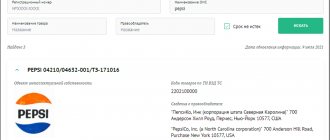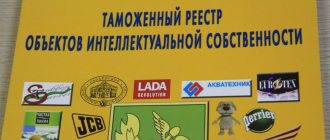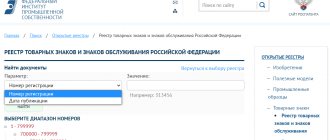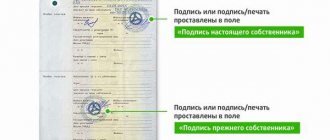A registered trademark or service mark is an object of intellectual property that is protected by law. The copyright holder has the right to declare the inclusion of information about the protected mark in the register of intellectual property.
This register is maintained by the Federal Customs Service. The Federal Customs Service ensures that the movement of goods across the border of the Russian Federation does not violate the rights of trademark owners. The procedure for entering information into the customs register of intellectual property objects was approved by Order of the Federal Customs Service of Russia dated January 28, 2019 No. 131.
Apply for trademark registration online
What is the customs register OIS (TROIS)
The Customs Register of Intellectual Property Objects (TROIS) is a register of objects of copyright , related rights, trademarks, service marks and appellations of origin of goods, in respect of which the federal executive body authorized in the field of customs affairs has decided on measures to prevent the release products from customs control.
The list of IPOs is constantly updated and access to it is open . Its task is to ensure the preservation of the exclusive rights of copyright holders who have entered their trademark into the system.
All information in the register is formed by trademarks , each of which displays information about its copyright holder, authorized representatives, range of goods, details confirming the protectability of the goods, and the date of inclusion in the list.
Useful
<
Copyright
Copyright Copyright includes the exclusive (property) right to a work and the moral rights of the author. To be granted copyright protection, a work must meet two criteria: be creative and exist...
Patent revocation
One of the common types of conflict situations in the field of intellectual property is the use of a patent for an invention or utility model similar to a previously patented one. If you find that your rights are being violated in this way,...
Cancellation of a patent for a utility model
The field of intellectual property is rife with conflicts. One of the common causes of disputes is the discovery of the fact that the development you are using is similar to another - already patented development, the patent for which belongs to another...
Patent challenge
The need to challenge someone else's patent may arise for several reasons. However, regardless of the root cause, this procedure is quite complex and requires separate consideration. The need to cancel a patent Someone else’s patent prevents registration...
Patent protection
Protection of rights to patents Patents in Russian legislation protect 3 types of results of intellectual activity: inventions, utility models, industrial designs. The object of protection by a patent for an invention can be a product or a method. Condition...
Challenging the right to a patent
A well-drafted patent application does not guarantee its receipt. The object that you want to protect under patent law must meet a number of requirements. This is not so easy to achieve, so it’s not uncommon...
Trademark protection
TRADEMARK PROTECTION Have you received claims of violation of exclusive rights? Patent attorneys from the leading Russian company ARS-Patent will help you find a solution, regardless of the level of complexity of the problem. What is considered a violation and...
Protection of trademark rights
A trademark (TM) is a designation that gives the necessary share of individuality to a company or a specific product/service. What is a trademark? In our country, the category of means of individualization includes various definitions. At that...
Illegal use of a trademark
The owner of a trademark (TM), registered accordingly, has the full right to use the mark and, accordingly, to suppress its unlawful use by third parties. Trademark infringement There are several types of infringement...
Protection of trademarks abroad
Its owner can be sure that full protection of a trademark (TM) will be ensured only if it is not possible to register a similar designation, both in Russia itself and abroad...
Termination of trademark protection
Termination of trademark protection Due to the fact that recently the registration of trademarks (TM) has been carried out more and more actively, the individualization of new products is becoming problematic. It’s not easy to come up with a bright...
Basic measures to protect intellectual property on the territory of the Russian Federation
In connection with the development of the market industry, where the subject of purchase and sale are intangible objects (IT developments, innovative technologies, books, etc.), the problem of protecting IP (intellectual property) is becoming increasingly relevant. Concept and types...
Domain name disputes
The Internet is an integral part of life and business today. The vast majority of companies have their own websites. The presence of an Internet site with a domain name identical to the means of individualization of the company contributes to the growth of its fame and recognition, increasing...
Right to own a domain
The right to own a domain In almost 100% of domain disputes, they are initiated by trademark owners. Domain disputes can be divided into two large groups: disputes over the ownership of the domain itself; disputes about...
Why do you need to register a trademark in TROIS?
The system under consideration is one of the main methods of the Federal Customs Service (FCS) to combat counterfeiting . Without including a trademark in the list, customs officers simply will not be able to find out about it and whose products it is. As a result, the copyright holder may encounter difficulties at customs control. Plus, only after registration you can protect your intellectual rights from criminals who counterfeit the brand.
Counterfeit goods are tracked by comparing cargo arriving at the border with the data that the copyright holder indicated in the TRIIS. If FCS employees have doubts about the legality of the goods, the inspector contacts the owner or representative of the trademark and clarifies the information on the delivery.
In general, the principle of operation of the system is simple : a copyright holder who suspects that his property rights may be violated submits an application to the Federal Customs Service, where the property is entered into the register (for example, a trademark). Customs authorities that have identified a product declared for declaration and having a property item entered in the TRIS may suspend the release of the shipment for 10 days to ensure that the rights of the copyright holder are respected.
Interesting things on the site:
Customs Union Certificate and how to get it
How is customs examination carried out?
How to obtain an electronic signature for customs and what it gives
Why enter data?
Registration of a mark in TROIS allows the manufacturer to perform the following functions:
- assess the actual volumes of imported counterfeit goods;
- protect the brand from counterfeit competition;
- strengthen our own position in the domestic market by reducing the volume of counterfeit goods;
- protect customers from low quality products;
- identify violators and stop the use of a trademark outside the law.
How to register a trademark in TROIS
To include a trademark in the system, you need to submit a corresponding application to the Federal Customs Service of the Russian Federation.
Attach the following package of documents to the application:
- Information about the copyright holder organization and confirmation that the company is active.
- List of representatives who will then interact with customs on behalf of the company.
- A document confirming exclusive rights to a trademark.
- A copy of the registration certificate of the mark , a certificate from FIPS (Federal Institute of Industrial Property) or the International Bureau of WIPO (World Intellectual Property Organization), as well as data on the alienation of the mark or the issuance of a license to use it.
- Information about the product (its description), persons who have the right to import and sell it, a list of customs posts where cargo can be transported.
- Data on counterfeit products (their description and documents confirming the import of counterfeit products), violators and customs posts where there is a possibility of their transportation.
- Property liability insurance contract , the amount of which must be at least 300,000 rubles.
The right to import products is given by the copyright holder : customs receives from him a list of persons who are vested with such a right. This list can be supplemented or shortened at any time.
The presented list of documentation is approximate . It is quite possible that when considering an application, the FCS will require clarification on the existing position, additional documentation, and evidence. A response to a customs request can be sent within 30 days from the date of its receipt. If later, inclusion in TRIIS may be refused.
All documents must be in Russian . If something is prepared in a foreign language, it must be translated. All copies are certified by a notary. When writing an application, it indicates the period for which the trademark will be included in the register.
Reference. According to statistics from the Federal Patent Bureau, the most difficult thing for a copyright holder is to prepare a sufficient amount of evidence of the existence of counterfeit products and the fact of their transportation into the country. If a company does not have enough evidence, it will be denied inclusion on the list.
Registration validity period
The copyright holder independently chooses the period during which the trademark will be in the register . However, this period cannot exceed two years.
Reference. It is necessary to compare the terms of registration in TRIIS and the terms of legal protection of an intellectual property object, since the first period cannot exceed the second.
If the period has expired, it is allowed to extend it as many times as desired, provided that the package of documents for registration is updated. The registration itself lasts 2-3 months, but the period can be extended if difficulties arise or there is a requirement to supplement the necessary documentation.
Making changes to the registry
Information about a trademark may change over time (for example, details of title documents, name of representative, etc.). Only the following persons can make adjustments to the information about the mark :
- copyright holder;
- law enforcement or other government agencies with evidence that the copyright holder is deprived of rights to the object or limited in them;
- individuals and legal entities with similar substantiated claims.
The decision to enter new data into TRIIS is made by the federal executive body authorized for customs affairs. The period for displaying the mark in the customs register may be suspended for the time required for verification. However, it cannot exceed two months.
Reference. The information contained in the register can be found on the official website of the Federal Customs Service and in its publications. Customs authorities publish them in the prescribed manner.
Customs suspension of objects of intellectual rights
According to norm 124 “Suspension of the period for the release of goods containing objects of intellectual property and the resumption of the period for the release of such goods” of the EAEU Customs Code, if customs officers find signs of violation of intellectual rights, they will delay the release of products by 10 working days . This period may be extended for another 10 days at the request of the copyright holder if he has applied for protection of his rights to the authorized body.
When the deferment for the release of the cargo ends, the release period for the goods is resumed . But if it turns out to be counterfeit, and this is proven by relevant documentation, it will be seized or confiscated.
Customs can delay not only the release of goods recorded in TRIS, but also other products if they contain a legally protected intellectual property item. This type of procedure is provided for by the Customs Code of the Customs Union and is called “ex-officio” . It is subject to the following restrictions:
- Customs officers must have information about the copyright holder and (or) his representative on the territory of Russia - this is a mandatory condition;
- Previously, ex-officio measures could not be applied to the property.
If one of the customs points of the state suspends cargo with a trademark that is not listed in the Federal Customs Service register , the same goods will not be able to be suspended again until the mark is entered into the TRIIS.
Fair prices for all types of services
has been successfully operating in the licensing market for more than 7 years. Based on enormous practical experience, highly qualified personnel and the requirements of current legislation, we will offer each customer a comfortable and mutually beneficial format of cooperation.
Our price offers are reasonable and are based on the actual volume and complexity of the work. The final cost of registration services and all the nuances are agreed upon with each client at the stage of drawing up the contract and then remain unchanged until the completion of the procedure.







